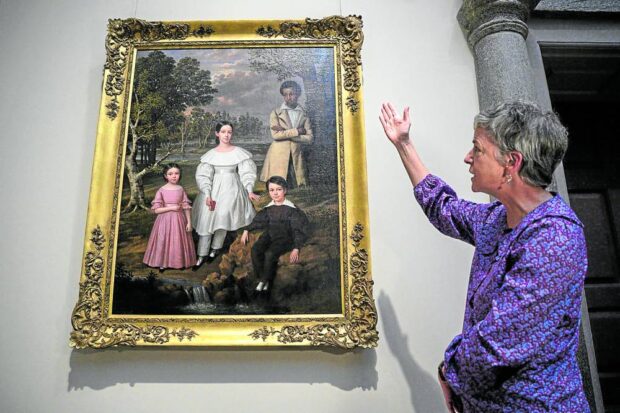
ALMOST LOST | Curator Sylvia Yount stands before Jacques Amans’ “Belizaire and the Frey Children.” The painting represents one of the rarest and most fully documented American portraits of a Black individual depicted with the family of his White enslaver. (Agence France-Presse)
NEW YORK — For years, the three children from a well-to-do New Orleans family seemed to be the only figures in a nearly forgotten painting attributed to French artist Jacques Amans.
The family’s slave, Belizaire, had simply been painted over. But this week the picture went on display — with his image restored — at the Metropolitan Museum of Art in New York.
The 1837 oil work represents “the first naturalistic representation of a named enslaved individual pictured in a Southern setting,” said Sylvia Yount, the curator in charge of the museum’s American wing.
And yet despite its significance, the young enslaved man — standing erect, arms crossed and with a grave expression — had nearly disappeared forever from the painting commissioned by the children’s father, Frederick Frey, a New Orleans banker from Germany.
READ: Leonardo da Vinci painting of Christ sells for record $450.3M in New York
READ: Luna or bust: Lost historic artwork finds way home
READ: Nasa buys Singaporean undergrad’s planetary artwork
The lad was painted over probably early in the 20th century. Frey and his wife were both dead by then, and the painting had been passed on to an heir.
“The family may not have been proud, or they may have been ashamed” to have an enslaved worker in the painting “because it really implicates them, you know, as a slaveholding family,” said Yount.
“The other side of that could be that they just didn’t want a black figure shown with their white ancestors.”
In 2021 Louisiana collector Jeremy K. Simien, a man passionate about representations of Creoles in local art, acquired the painting and hired expert Katy Shannon to delve into the Louisiana archives.
There she discovered that the young man was named Belizaire, who was later sold to a sugarcane plantation.
“We know he did live past the Civil War and [had] become free,” Simien said.
“He serves kind of as a representation of a lot of history that was erased or covered over.”

